cement industry
New Comments from EPA on DFW Air Plan: It Won’t Work
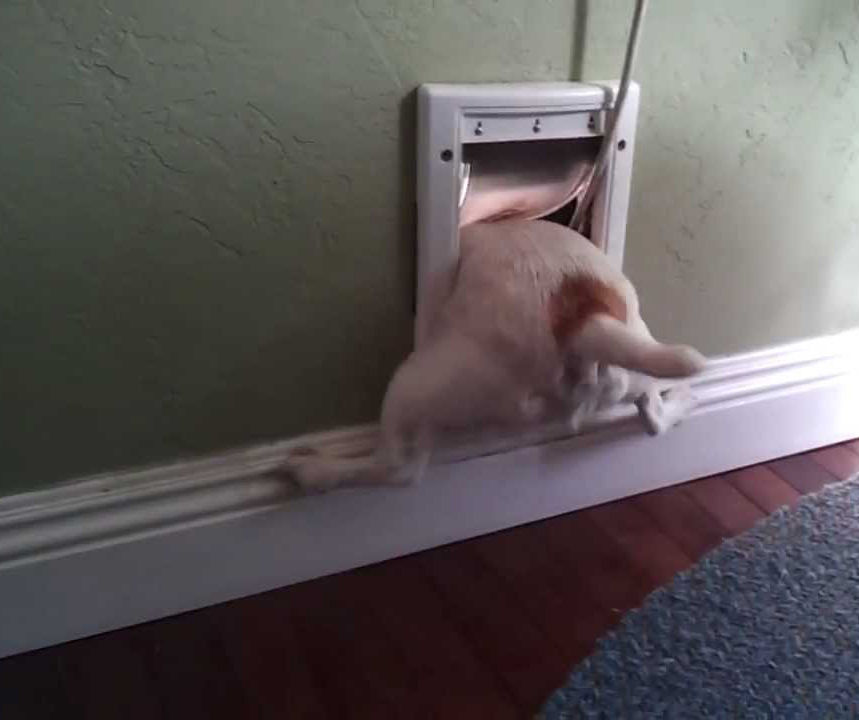 This plan won't work.
This plan won't work.
That's the simple message from the three pages of new comments Region 6 EPA staff submitted to the Texas Commission on Environmental Quality last month concerning its anti-smog plan for DFW.
That message begins with the cover letter, written by Mary Stanton, Chief of the State Implementation Plan Section for Region 6. "… additional local and regional ozone precursor emission reductions will be necessary to reach attainment by 2017."
How much in reductions? EPA estimates an additional 100-200 tons per day more in cuts of smog-forming pollution will be necessary to achieve compliance with the current 75 parts per billion ozone standard. "Without emission reductions on this scale, it is unlikely that the area will attain by the attainment date.”
To give you some idea of how large a number that is, TCEQ calculates that all gas and oil air pollution in DFW equals 78 tons per day, the Midlothian cement plants belch out over 18 tons per day, and all the power plants in the immediate DFW area, 21 tons per day. Totaled, those three sources add up to 117 tons of pollution a year.
All the cars and trucks on DFW roads are said to add up to 180 tons per day of pollution.
So the decrease in pollution EPA is saying is necessary to get down to the current ozone standard is huge.
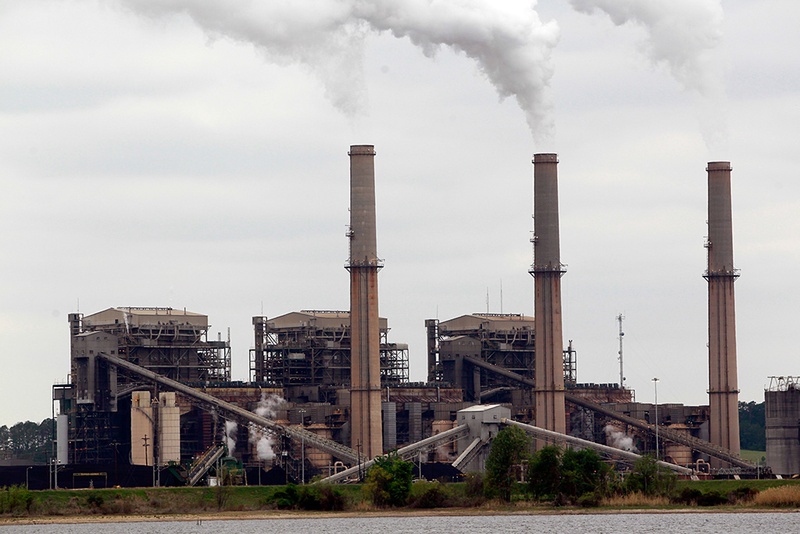
But take a look at those obsolete East Texas coal plants outside the boundaries the DFW nonattainment area. TCEQ says they account for a total of 146 tons per day. Add Selective Catalytic Reduction (SCR) which can get you up to 90% reductions in coal plant emissions, or close them down completely, add decreases from new controls on the cement kilns and oil and gas sources, and you're well on your way to amassing 200 tons a day of cuts in pollution.
Which do you think is more attractive to most DFW residents: permanently parking their cars, or putting new controls on the coal plants? Even though the coal plants harm the whole DFW airshed more than any other major source, they're not held accountable to the same regulatory requirements as sources closer to the center of the urban core, but which have less impact. Our cars must have special gasoline formulas in summer, we have to have HOV lanes, and we still go through Ozone Action Days, but the coal plants party like it's 1979. TCEQ is taking a hands-off approach to the plants and as a result the DFW region will continue to be in violation of the smog standard or huge cuts from other sources will be necessary.
TCEQ could have added new controls to the coal plants to the plan, but it chose not to. In fact, there are no new controls in the state's plan on any major sources of air pollution affecting DFW. EPA's new comments go to the heart of that choice. "Without additional emission reduction measures, we don’t see how the area will meet the standard of 75 ppb by the end of the 2017 ozone season," writes EPA staff.
EPA goes on to say TCEQ's computer modeling supporting it's do-nothing plan is "unrealistic," severely underestimating future smog levels, and delivering projections of decreases "that seem unlikely to be reached."
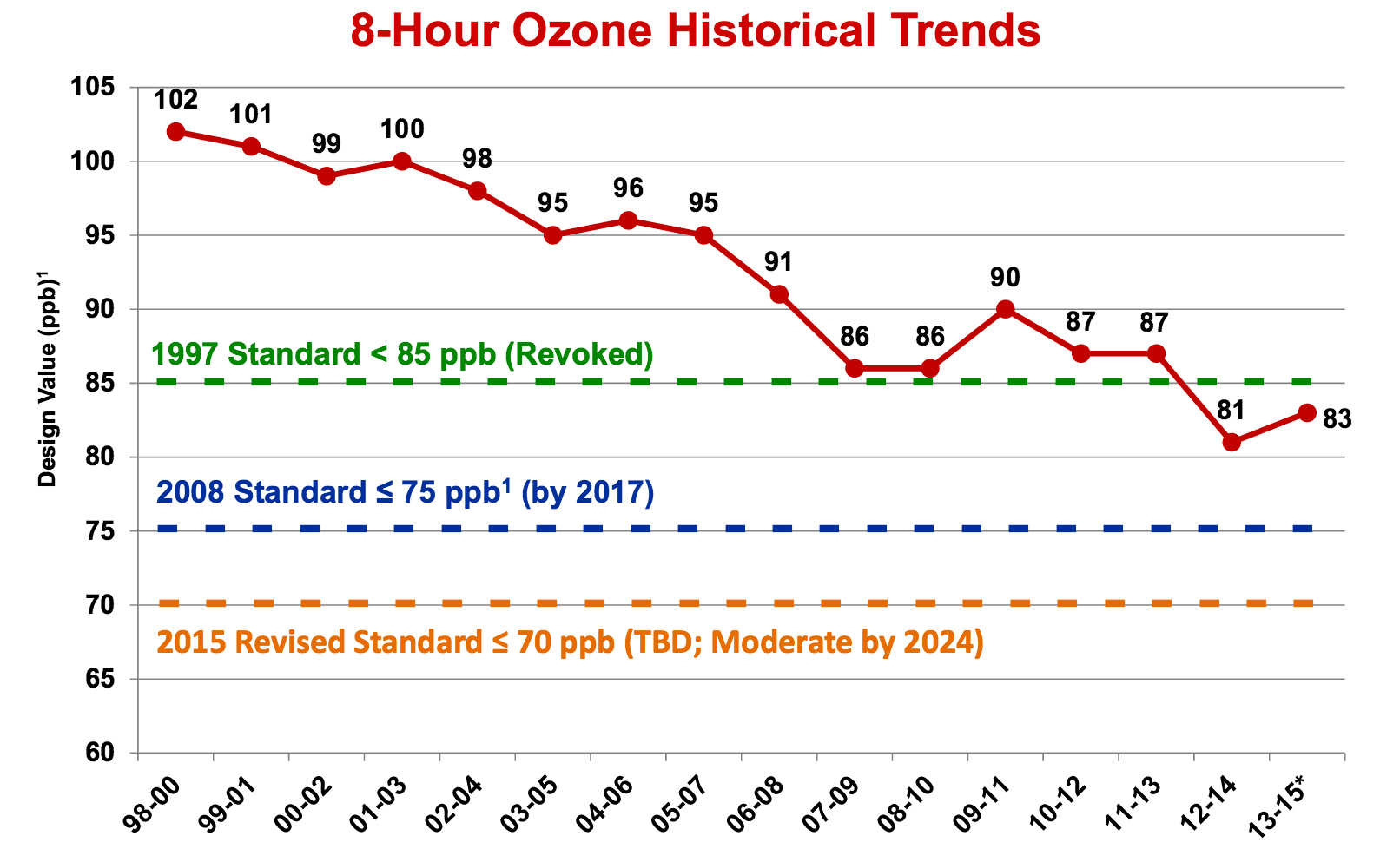 With this stance, EPA seems poised to reject this "attainment demonstration" part of the air plan as being insufficient. But it must wait to see how TCEQ responds to EPA comments about its modeling shortcomings and need for new cuts when the state officially submits its plan this July. Then, and ony then can the Agency approve or disapprove. We're going out on a limb here and predicting TCEQ won't change a thing, thus inviting EPA disapproval.
With this stance, EPA seems poised to reject this "attainment demonstration" part of the air plan as being insufficient. But it must wait to see how TCEQ responds to EPA comments about its modeling shortcomings and need for new cuts when the state officially submits its plan this July. Then, and ony then can the Agency approve or disapprove. We're going out on a limb here and predicting TCEQ won't change a thing, thus inviting EPA disapproval.
That's the pattern TCEQ has already established with its "screw you" response to the EPA's comments about the part of the plan dealing with "Reasonably Available Control Technology," or RACT, last February. This second part decides what new controls should be required of major sources of air pollution within the 10-County DFW "non-attainment" area – like the Midlothian cement plants and the thousands of oil and gas facilities checkerboarding the western half of the Metromess.
TCEQ says nothing new is required. EPA disagrees. EPA told TCEQ last year it had to do a new RACT review and lower the kiln's emission limits to account for a new generation of technology or it would have to reject the state's plan. TCEQ ignored the request, daring the EPA to disapprove. EPA seems more than willing to take them up on the offer.
And so while you're waiting for the state's computer modeling and suspect math to be rejected by EPA in July, you can probably expect to see EPA officially rejecting the RACT part of the state's plan sooner – maybe as soon as the next 60-90 days.
Despite the TCEQ going out of its way to submit an unacceptable plan to EPA, if the Agency pulls the trigger and begins a federal takeover of the DFW air plan, the Commission and the whole of Texas State Government will cry bloody murder about the usurpation of the state's authority and once again proclaim how "out of control" the EPA is on their way to filing suit.
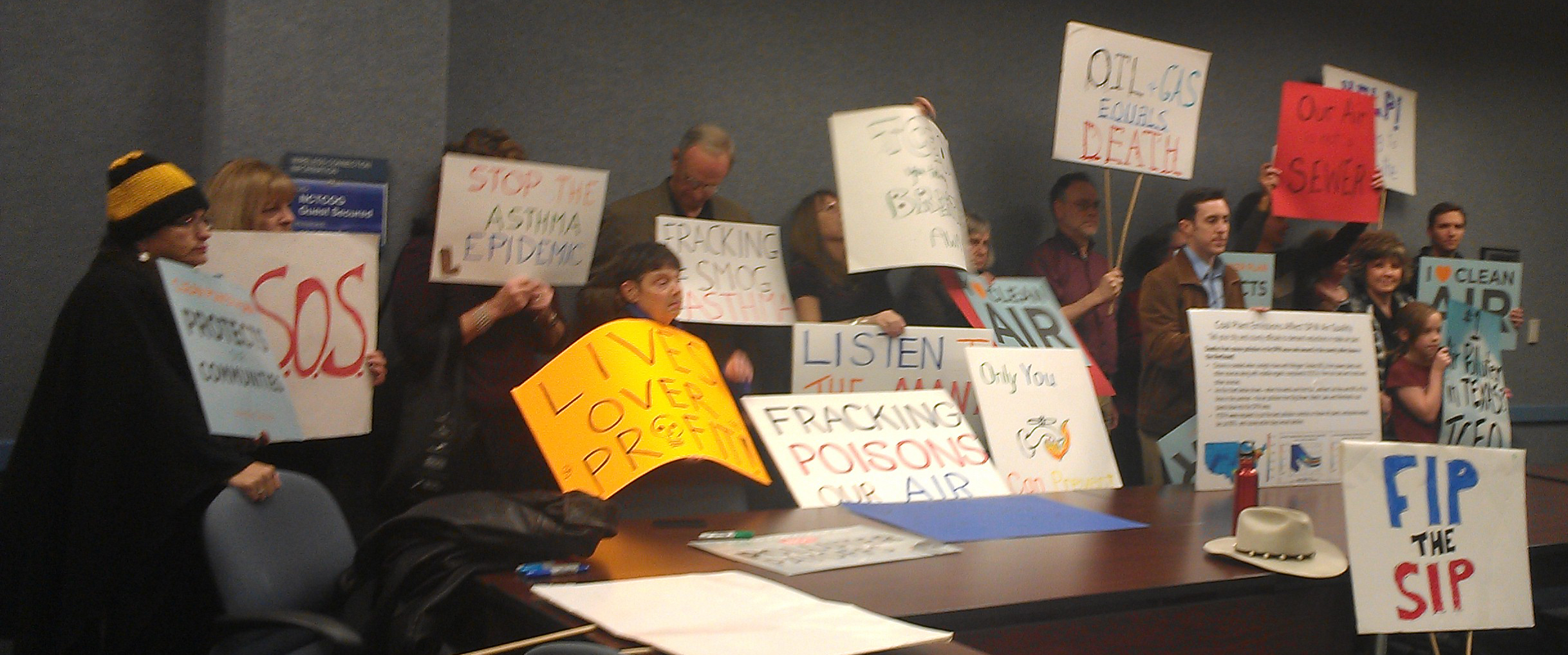 This is why the rowdy eruption of public sentiment for an EPA plan at the hearing in Arlington two weeks ago was so critical (Thank you again). It's also why we now have to be about the business of getting DFW local governments, hospitals and school districts to pass resolutions in favor of an EPA takeover. The Agency will need this kind of public support to counter all the criticism it will take from the Usual Suspects in Austin and DC. If you're interested in helping us pass one of these resolutions in your county, city, school or hospital district, please let us know at: downwindersatrisk@gmail.com
This is why the rowdy eruption of public sentiment for an EPA plan at the hearing in Arlington two weeks ago was so critical (Thank you again). It's also why we now have to be about the business of getting DFW local governments, hospitals and school districts to pass resolutions in favor of an EPA takeover. The Agency will need this kind of public support to counter all the criticism it will take from the Usual Suspects in Austin and DC. If you're interested in helping us pass one of these resolutions in your county, city, school or hospital district, please let us know at: downwindersatrisk@gmail.com
And as always, it's why you, and people you know should:
Thank You…for Kicking Serious State of Texas Butt Last Night
 Those were not your father's treehuggers that showed up in Arlington last night.
Those were not your father's treehuggers that showed up in Arlington last night.
Over 100 people, including 36 speakers over three hours, provided perhaps the angriest, and certainly the most profanity-laced evening of testimony ever heard in the two-decade history of state public hearings on DFW's dirty air. It's as if frustration over the last 20 years of State failures had finally found a cathartic, public release.
For the most part, speakers from communities across North Texas ignored the State and spoke directly to representatives of EPA, pleading for the Agency to take air quality planning out of the hands of a hostile Texas Commission on Environmental Quality.
But when many speakers did address the State's efforts, they didn't parse any words – at least any words that can be printed in a family newspaper, or this blog. For the first time anyone can recall, f-bombs were hurled at TCEQ over its failure to take North Texas bad air seriously. Dallasite Gary Stuard set the tone for the event early on by saying it was time for residents "to quit being so polite" about their systematic poisoning. His message was taken to heart by many of the speakers that followed.
Old, young, male, female, Black, White, Latino, mainstream group, neighborhood group, Elected officials, students, business owners, doctors, asthma suffers, parents of asthma suffers, people concerned about climate change, about fracking, about coal plant pollution, about cement kilns – it didn't matter. Not a single speaker spoke in favor of the State's plan of doing nothing about rising smog levels.
Seizing on the day's headlines, Lance Irwin from Mansfield was the first, but not last person to compare the official neglect over lead in Flint, Michigan's water supply to pollution in DFW's air supply. Arlington residents spoke – and in one instance, sung – movingly about fracking contamination making their neighborhoods unlivable. More than one testimony was dedicated to a friend or relative who'd died from a lung disease. Equal parts despair and anger.
By the time the final speakers finished, it felt more like a church revival. The Church of the Unredeemed State Agency. When was the last time you heard people say they had "fun" at a pro forma public hearing?
To be sure, more traditional voices and statements were in full force. Congresswoman Eddie Bernice Johnson sent a staff member urging the State to redo its plan. Dallas County Commissioner Theresa Daniel sent her aide to talk about the need to control coal plant pollution in the plan. Dallas City Councilwoman Sandy Greyson spoke for the need to grab this opportunity to make progress. Dr. Robert Haley of the Dallas County Medical Society and UT-SW did an excellent job of summarizing his recent study on the public health and economic costs of DFW smog and speaking to the Texas Medical Society resolution against the state plan. Rita Vinson, newly elected President of the Fort Worth League of Neighborhood Associations read a unanimous resolution passed by her group only the day before, calling for EPA to reject the plan. Lots of speakers recounted the long and winding road leading up to the current fact that DFW now has worse smog than Houston.
But it was the tossing aside of business meeting protocol and the pretense that the State had any interest in being there that made this a milestone event. Veterans of past hearings talked about how tired they were of repeating themselves. Newcomers couldn't understand how a State government that doesn't think smog is bad for you can write an effective anti-smog plan. Dentonites were rightfully resentful of seeing a plan that does nothing about smog from oil and gas sources being promoted by the same government that stole its municipal rights to regulate it themselves. Coarseness in language reflected rawness of feelings over yet another Texas attempt to undermine the EPA.
Although the weather was nasty, the major obstacle organizers faced yesterday was understandable skepticism about what good it would do to go to another useless TCEQ hearing. The answer was the need to provide EPA with political support to prepare for a federal takeover. That happened. Big Time. For three solid hours.
Thank you to everyone who participated in the worst public ass-kicking the TCEQ has ever received in DFW.

Now what?
EPA sent three staff members, including those in charge of reviewing and commenting on the State plan. They took notes. We'll get to see what the Agency thinks about this "new" plan within the next three weeks after the comment period closes and its written review becomes part of the public record.
After that, it should be a relatively short time before EPA decides to officially reject the part of the plan dealing with new controls in the 10-County "non-attainment area" – the part the State didn't do even after EPA asked TCEQ to, and explicitly told the Commission it would reject the plan unless it did.
It will take EPA longer, perhaps until the end of the year, to make a decision about the rest of the plan – the part that relies on computer modeling and estimates of future pollution. It's more technically oriented and there's more nuance than the up or down legal opinion with the control section.
And for citizens?
Send an email to EPA urging them to reject the State's awful air plan for DFW
Sign the CHANGE.ORG petition urging EPA to reject the State's plan
Forward our two-and-a-half minute video to people you know are concerned about air quality – or should be.
Submit written comments on this plan to the TCEQ:
Please reference: "Dallas-Fort Worth Attainment Demonstration for the 2008 Eight-Hour Ozone Nonattainment Area, Project Number 2015-014-SIP-NR"
via the interwebs:
http://www1.tceq.texas.gov/rules/ecomments
or fax
(512) 239-6188
Or by snail mail:
Kathy Singleton,
MC 206,
Air Quality Division, TCEQ
P.O. Box 13087
Austin, Texas 78711-3087
And get ready to campaign for resolutions supporting an EPA clean air plan for DFW from your local city council, county government, hospital districts, and school boards. We're all about building support for a federal takeover of our air quality planning between now and the end of the year when EPA is expected to make its final decision. We're coming to a governmental entity near you!
Lots is at stake. We can win the largest improvement in DFW air quality in a decade or wait another five years to try. Thursday night's showing makes clear many of us aren't willing to wait.
Onward Thru the Smog.
Study: Combusted PM Pollution Up to Five Times as Lethal As Non-Combusted Kind. Burning is Bad.
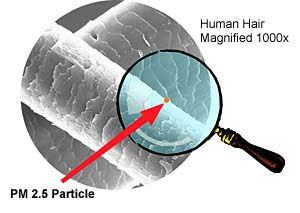 Long term exposure to small particulate pollution from combustion sources, specifically coal-fired power plants, is up to five time more likely to kill you through heart damage than other forms of natural or human-made "PM."
Long term exposure to small particulate pollution from combustion sources, specifically coal-fired power plants, is up to five time more likely to kill you through heart damage than other forms of natural or human-made "PM."
That's the conclusion of new comprehensive study comparing risks from breathing-in the tiniest specs of soot from combustion sources for over 450,000 Americans in 100 cities from 1984 to 2014. Published in the journal Environmental Health Perspectives this month to coincide with the Paris climate talks, the study has ten co-authors and promises to be a milestone in the long fight to reduce this form of pollution.
Combustion of any sort releases fine and ultra-fine particles of soot, or "Particulate Matter" in the often antiseptic regulatory-speak of environmental regulation. These specks differ from dust particles or fireplace soot in that they're much, much smaller and so can be inhaled deeper into the lungs, and then, even pass from the lungs into the blood steam to affect other organs and systems. It's their tiny size that makes PM pollution dangerous on its own. Over the last 30 years, scientists and public health officials have gone from being worried about PM 10 (10 microns or less), to PM 2.5 (2.5 microns or less – about 100th of the width of a human hair), to Ultra-fine Particles.
But soot from combustion also carries residues of whatever was being burned in the facility it came from, and this makes it doubly toxic. If you're burning coal, the soot might carry bits of Mercury, Arsenic, Cadmium and Lead, for example. The new study says that difference is what really drives up risk for people breathing-in coal plant PM.
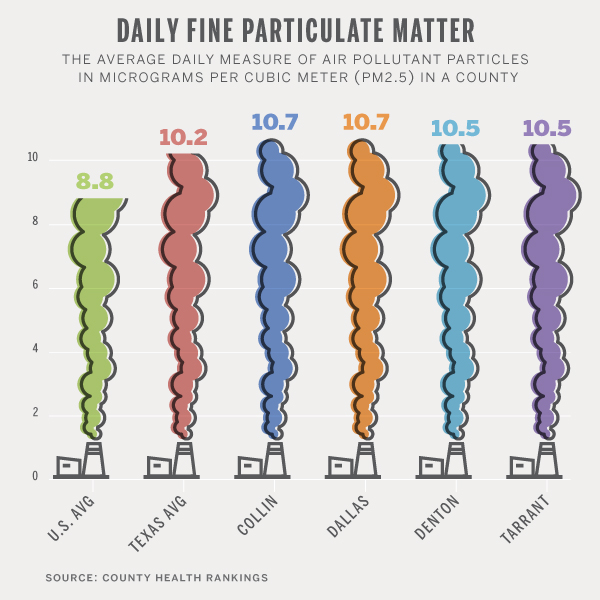
Locally, DFW is chock full of large industrial sources of combustible PM.
We're surrounded by five coal plants in an arc on its northeastern to southeastern side. That means we're downwind of their pollution, including their particulate matter pollution, most of the year. Their impact on local smog levels has recently been chronicled by Downwinders' study from UNT.
PM Pollution would follow approximately the same patterns although heavier particles fall closer to the source, while the really fine particles drift for hundreds or thousands of miles. Luminant’s 2013 Emissions Inventory submission reports 1400 tons of 2.5 particulate matter in a single year at its Big Brown plant. And that may be a severe underestimate. Big Brown’s two Units have exceeded the Texas SIP’s opacity limit of 30 percent on thousands of occasions over the past decade.
Luminant's Martin Creek plant released 2,018 pounds of mercury into the environment in 2013, according to the Toxic Release Inventory, and in fact Texas hosted the top three mercury polluters among all coal plants in the US that year.
Closer in, there's the three Midlothian cement plants with a total of four kilns now. Modernization and controls forced by 20 years of campaigning by Downwinders have brought the numbers down dramatically, but they're still huge facilities that deal in both a dusty raw material, and burning lots of coal and industrial wastes like tires and used oil, and even car parts, to turn that into a higher grade of raw material. When you burn exotic materials with coal, you turbocharge the toxicity of the PM pollution even more. In 2013, the last year the state has numbers posted online, the three cement plants released approximately 440 tons of 2.5 PM pollution.
But cement plants weren't included in the study and so the risk evaluations in it for DFW are underestimated.
Midlothian is also the home to the very large French-owned Amersteel (formally Chaparral Steel) secondary steel mill and steel mills were included as a source category in the study and were also associated with a higher mortality rate. Just about every 18-wheeler trailer you see on local highways loaded with crushed cars is headed to this facility – across the street from the TXI cement plant. Imagine the residues on the soot from melting down thousands of used cars into liquid metal. In 2013, the plant released 133 tons of PM 2.5.
But by far, the largest PM polluter in the DFW area, bar none is the Owens-Corning fibreglass plant in north Waxahahchie, along I-45. It released a whopping 300 tons of PM 2.5 pollution in 2013 alone. No other facility comes close – not the cement plants or the steel mill down 287. Not the GM plant in Arlington. It's not known how much of Owens-Corning PM is combusted however. It could be from the manufactiuring process.
Diesel engines in vehicles were also included, and the study found they has an association with higher mortality, but not nearly as significant as coal plants or steel mills. There's been a steady stream of studies tying highway pollution to respiratory and neurological illness among near-by populations, especially children. Most of the risk is assigned to PM pollution, and most of that is coming from diesels.
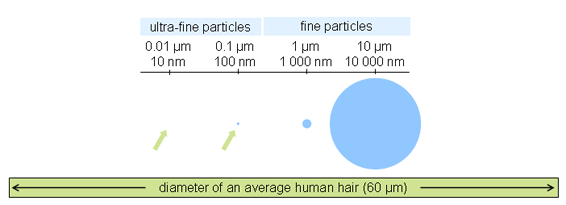
Just as important as the conclusion that coal-combusted particulate matter is significantly more dangerous than your average speck of dust is the study's indictment of current EPA risk assessments that operate on exactly the opposite assumption. The authors are critical that the Agency still weighs the risk of desert dust the same as combusted soot in computing long-term human health effects.
There are potentially enormous public heath and policy implications for North Texans in the study's conclusions.
First, the campaign to get the most modern anti-smog controls included in the latest DFW air plan has the side benefit of reducing PM pollution too. Selective Catalytic Reduction (SCR) on the cement kilns and coal plants decreases smog-forming pollution by up to 90%, and makes an effective additional PM catcher as well, increasing soot capture by 30-50%. The technology is particularly effective on the kind of PM that carries dangerous heavy metals like Mercury. Of course, retiring already-obsolete coal plants would eliminate the threat all together.
Likewise, electrification of compressors would not only lead to decreases in smog-forming emissions, but PM pollution from those sources as well.
Next, it means the already large public health costs of bad air in DFW just published by Dr. Robert Haley of UTSW in his own study are severely underestimated, since they were based on the EPA's own risk assessment software that doesn't weigh the harm of coal power plant PM differently from any other speck of PM 2.5. Adjust those numbers for the exposure to toxic soot and you could see a huge increase in lives lost, illness caused, and dollars spent.
Finally there are implications for almost very other source of combustion around – burning is bad. Where's there's a flame, a boiler, a furnace, a process that means burning something to get something in return, there's going to be PM pollution. What you burn is as important as how you burn it. Burn coal and get the residues of coal on the PM. Burn hazardous waste, and you get the residues from those wastes on the PM. Burn diesel fuel in your truck or car and get residues from that fuel mix packed away in your particulate matter.
As one of the major authors of the study said, if you want to do something about this kind of pollution – start with the most toxic forms of combusted PM. Those mostly come from large industrial sources – the coal plants, cement kilns, and compressors already in our sights because they're also smog polluters. We knew they were a problem. Now we know even more about why they're a bigger problem.
State Re-Submits Illegal DFW Smog Plan, Dares EPA to Reject It

(Dallas)– In an unprecedented rebuke to the Environmental Protection Agency, Texas has refused to provide critical data EPA says it needs to approve the state’s controversial anti-smog plan for DFW, which requires no new pollution controls despite more than two decades of chronic bad air.
Texas' refusal to cooperate with EPA puts its plan, scheduled to be approved by the Texas Commission on Environmental Quality December 9th, on a collision course with the federal agency.
Although EPA gives state governments authorization to write smog plans for their own metropolitan areas, it still has final approval based on criteria listed in the Clean Air Act. EPA disapproval of the State's DFW plan would trigger the possibility of a federal takeover of the air planning process.
That would be fine with local air quality activists, who've been pushing for the EPA to take over the job of writing a new clean air plan for North Texas since the State unveiled its first draft last year. They say TCEQ's official position that smog isn't harming public health means the Commission can't be trusted to write an effective anti-smog plan. When the state announced a plan imposing no new controls on any sources of air pollution despite DFW being in continual violation of the Clean Air Act for the last quarter century, they feel they were proven right.
"It's as if the state is too embarrassed to do what EPA is asking for fear of finding facts that don't match its ideology," said Jim Schermbeck, Director of the local clean air group, Downwinders at Risk.
He noted among the most important missing items in the State’s final plan published November 20th was a "Reasonably Available Control Technology"(RACT) study for the Midlothian cement plants, as well as answers to the impact of controls on other sources like the East Texas coal plants and oil and gas facilities that EPA posed in its eleven pages of official comments on the first draft last February. Application of modern pollution controls to all major sources of air pollution in a smog-plagued region is a key component of the Clean Air Act.
In official comments last February, EPA specifically requested the state perform a new study of what kind of smog controls should be required of the three Midlothian cement plants immediately south of DFW. EPA warned lack of such a study would mean the plan would be disapproved:
"Failure to conduct a thorough RACT analysis for cement kilns which would include appropriate emission limits would prevent us from approving the RACT portion of the attainment plan submittal.”
By turning-in the same version of the technology review originally criticized by EPA, without any new additional analysis, the TCEQ began a bureaucratic game of "Chicken," daring the EPA to deny approval.
"If you're EPA, I don't see how you take this any other way than a big raised middle finger from Austin," said Schermbeck. "The question is: What's EPA gonna do about it now?"
Also missing in the final state version are any responses to other EPA's concerns and questions about the plan's chances of actually lowering smog levels and the possibilities of reducing smog with new controls on other sources, such as,
“How would a reduction in NOx emissions from utility electric generators in the counties closest to the eastern and southern boundaries of the DFW area impact the DFW area?”
EPA was already openly skeptical about the chances of the state’s plan succeeding without requiring any additional cuts in pollution. Stating “it would be difficult to see” how the plan meets its required 2017 deadline, the Agency concluded “we believe it is likely that additional reductions will need to be included to demonstrate attainment.”
TCEQ’s resubmitted plan doesn’t have any additional reductions. Failure of a state plan to show how it can reach the smog standard by 2017 would be cause for EPA to assume the job itself.
Evidence suggests the state is purposely overlooking the air quality benefits of controls on large industrial sources of air pollution affecting DFW.
In late October, Downwinders at Risk released a new study of its own. It paid for University of North Texas engineers to build a clone of the State’s DFW air computer model and run a series of control scenarios the state hasn’t performed in almost a decade. Using the TCEQ’s own numbers it showed new controls on the cement kilns, coal plants, and gas compressors in the Barnett Shale would lower smog levels enough to meet the current federal smog standard. DFW hasn’t met a federal standard for smog since once was created in 1991.
Dismissing the results as “limited,” TCEQ officials nevertheless agreed with them – since they were based on their own model. The State argues those new controls are not yet technically or economically feasible – despite their being commonplace around the world, in the US, and even in Texas.
This question is one of the keys to the standoff with EPA: are the proposed new controls for industry “Reasonably Available” or not? If they are, they must be included in the air plan. If not, they remain off the table. EPA makes the first call on a definition, and any aggrieved party can sue to expand or contract it.
Because it’s a national hot spot for smog, DFW is only one of a handful of US metro areas that even had to submit a clean air plan this last cycle. EPA computer modeling predicts the area will still be in violation of the Clean Air Act in 2015 unless significant reductions in pollution are made.
This summer saw the North Texas regional smog average rise twice in one hot August week, retreating from gains made during last year’s cooler, wetter summer. DFW once again has higher annual smog levels than Houston. Both cities remain well above the current standard.
According to the American Lung Association, the 10 county DFW “non-attainment” area for smog includes approximately 150,000 asthmatic children, 350,000 adults with asthma, and over 600,000 adults with cardiovascular disease or COPD – all of whom are at risk from the region’s bad air.
“The lungs and lives of seven million residents are being held hostage by a state government that doesn’t think smog is a problem and isn’t willing to require new pollution controls to reduce it, “ Schermbeck pleaded
“Expecting the State of Texas to enforce Environmental laws in 2015 is like expecting the State of Mississippi to enforce Civil Rights laws in 1965. Our only hope is federal intervention.”
Spanish Study: Link Between Cement Kilns and Cancer
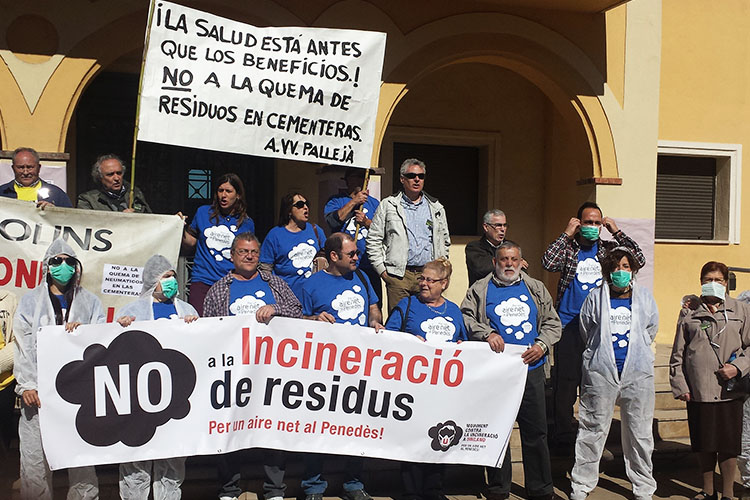 Although it was first published last July, news of a new Spanish epidemiological study of residents living in proximity to cement plants has just now reached us.
Although it was first published last July, news of a new Spanish epidemiological study of residents living in proximity to cement plants has just now reached us.
Done by the the same researchers responsible for a 2012 study that found statistically significant increases in all cancers around waste incineration and auto scrap metal operation, this more recent report focuses just on cement, lime and plaster plants.
According to the researchers, a statistically signifiant increase in all cancer mortality was detected in the vicinity of these installations as a whole, but principally, in the vicinity of cement installations. Specifically, tumors of the colon–rectum in both sexes and of the pleura peritoneum, gallbladder, bladder and stomach in men were noticably higher. In a summary of the results, the authors state they believe residents have "an excess risk of dying from cancer, especially in colon–rectum, in towns near these industries."
Because they take such a long time and so much effort, there's a dearth of epidemiological studies focused entirely on cancer risks among those living in proximity to cement plants, although a 2004 Italian study found a significantly greater risk of lung cancer among people living near a cement factory (whereas the results of another Italian study confirmed significant excesses for cancers like the nervous system, leukemia, mesothelioma and peritoneum in a region with the presence of various industries including cement factories.
In explaining the higher incidence of gut cancers among both men and women, the study hypothesizes about the possible ways local residents are exposed to carcinogens:
In our study, one aspect to be borne in mind is that colorectal
cancer is the only tumor with statistically significant excess risks
in men and women, which might be indicative of a pathway of
environmental exposure. In this case, two possible routes of exposure
to the pollution released by these installations are considered:
direct exposure to pollutants released to air; and indirect exposure,
both to pollutants and liquid effluents which are released to water
and can then pass into the soil and aquifers, and pollutants which
are released to air and then settle on plants. In such cases, the toxins
may pass into the trophic chain, affecting the population.Some authors have already shown associations between colorectal cancer and proximity to industrial pollution sources as metal industries (Garcia-Perez et al., 2010), mining (Fernandez-Navarro et al.,2012), food and beverage sector (Lopez-Abente et al., 2012) andchemical plants (Wilkinson et al., 1997). As regards cement plants,
a Brazilian study found a significant elevation on colorectal cancer
mortality in an industrialized area with cement industries came
into operation in the 1960s, among other facilities (Medrado-
Faria et al., 2001), and a Korean occupational study suggested a
potential association between exposure in the cement industry
and an increased risk of rectal cancer (Koh et al., 2013).
One thing a lot of these overseas studies and the Midlothian area have in common is a concentration of heavy industry. There's usually more than one facility and the region is considered an industrial corridor. That's certainly true of Midlothian, where besides hosting three large cement plants, the town is also home to a huge secondary steel mill, a power plant, and now an LNG plant. These industries combine to present a multitude of possible synergestic combinations of toxins to anyone living adjacent to, or downwind of them. "Toxic soup" is a term often used to describe the result.
This is also why the law lags behind the science in setting standards for cause and effect. When it's the cascade of chemicals from various facilities assaulting you, you're rarely going to be able to link a particular disease or illness with a specific plant. And yet the harm is happening all the same. This is why institutionalizing the "Precautionary Principle" into public policy is so important. It's much easier to prevent a chemical exposure than to track all of its ill effects after it's already doing damage.
Another Reason to Hate K-Cups: They Could End Up in Your Lungs
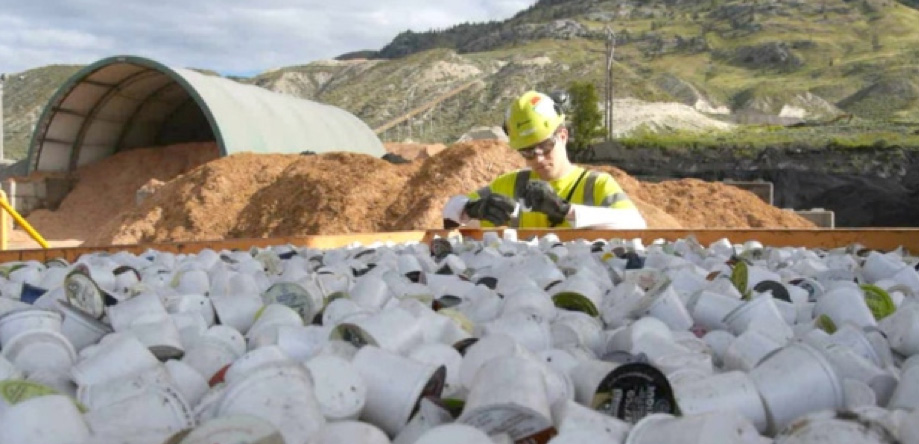 A new frontier in "alternative fuels" for cement kilns has opened up. A LaFarge cement plant in British Columbia has begun burning used plastic single-serving Keurig coffee cups, otherwise known as "K-Cups."
A new frontier in "alternative fuels" for cement kilns has opened up. A LaFarge cement plant in British Columbia has begun burning used plastic single-serving Keurig coffee cups, otherwise known as "K-Cups."
The cups aren't recyclable because they're a mixture of coffee grounds, paper filter, plastic cup and foil top that can't be efficiently separated.
The plant's manager says that the cups are "becoming more and more of a component of our waste steam." A chain delivers the spent cups in large bins. in 2014, over 80,000 pounds, or 1. 4 million, of them were burned at the plant.
Of course, LaFarge claims that the cups are "completely combusted." No mention of the increase in Dioxins/Furans, Polyaromatic Hydrocarbons, or other carcinogens created when the plastic is burned and complete combustion isn't do complete.
K-cups are just the latest piece of "unrecyclable plastic" to be added to the waste stream pouring into cement plants all over the planet. Although the use of hazardous waste as fuel has declined since the 1990's, the use of "industrial wastes" has soared as plants try to find free or subsidized sources of fuel to take the place of coal. Fuel costs are as much as a third of the operational expense of running a cement plant.
Although this new trend hasn't been embraced by Midlothian's three cement plants yet (as far as we know), the permits for TXI and Holcim allow the burning of plastics (along with a host of other industrial wastes), so it's conceivable a K-Cup bonfire could be coming to a kiln near you soon.
A report in February by the group As You Sow, specifically identified the food industry as a large generator of unrecyclable plastics. And one of the biggest culprits it spotlighted was the K-Cup, of which 9.8 billion were produced in 2014 alone. That's enough to circle the globe ten times with the small plastic shells. The Cup's waste is so ubiquitous that it's creator is now said to regret he ever invented it.
One media outfit began using the Cups but then "very quickly realized that this packaging was a problem." So Egg Studios produced a short "Cloverfield" parody where the plastic cups become the weapons of choice for an alien invasion. It's called "Kill the K-Cup.
Downwinders and Sierra Club File Joint Comments on the State’s DFW “Do Nothing”Air Plan
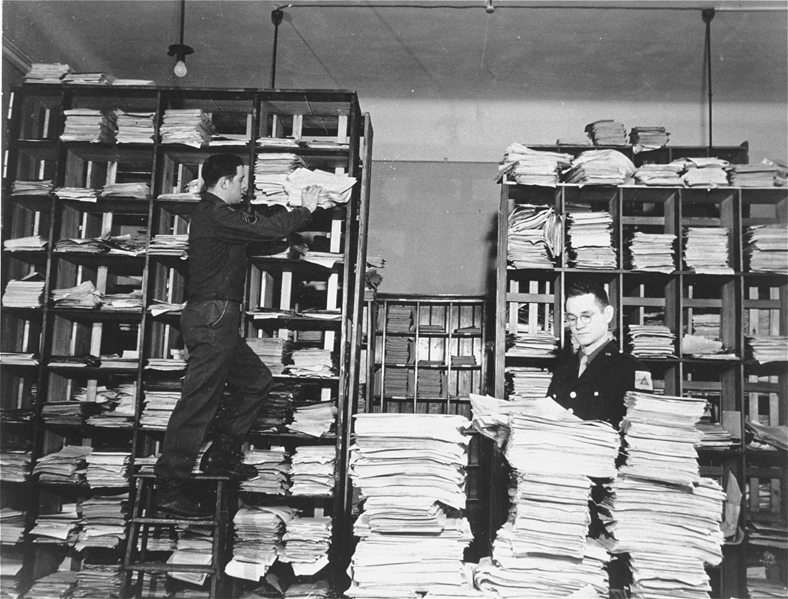 Wednesday of last week saw the deadline for filing official comments on the dreadful "plan" the Texas Commission on Environmental Quality has proposed to lower smog levels in DFW by 2018. In effect, the plan is to wait for federal gasoline changes in 2017 and hope for the best.
Wednesday of last week saw the deadline for filing official comments on the dreadful "plan" the Texas Commission on Environmental Quality has proposed to lower smog levels in DFW by 2018. In effect, the plan is to wait for federal gasoline changes in 2017 and hope for the best.
Shortly before closing time Wednesday, Downwinders at Risk and the Lone Star Chapter of the Sierra Club submitted 62 pages of criticisms concerning the plan. Not because either organization believes the TCEQ Commissioners will change heir minds, but because we're trying to establish a record that might eventually lead to a court challenge of the plan.
Although lengthy, the basic approach of the groups is two fold – call into question the state's computer modeling that's predicting success and challenge the state's exclusion of new pollution control measures on the Midlothian cement plants, East Texas Coal plants and Barnett Shale gas compressors.
Some of the highlights:
– The computer modeling the TCEQ is using for its new plan is the same it used for plans in 2006 and 2011, neither one of them successful at meeting its goal of cleaner air by the assigned deadline. In fact, the last clean air plan using this same model underestimated smog levels by almost 10 parts ber billion and actually saw a slight rise in smog at its conclusion – the first time a DFW plan ever resulted in higher ozone levels.
– In defiance of EPA guidance, the computer model TCEQ is using is more than five years old. EPA specifically recommends using an "ozone season" from 2009 to 2013. TCEQ's model is leftover from 2006, or three years older than the oldest year EPA says is appropriate.
– Also contrary to EPA rules, the TCEQ 2006 computer model ignores including the most relevant “meteorological conditions conducive to elevated air quality.” 2011 was the worst year for ozone levels in DFW since the beginning of this decade, in large part because it reflected the worst drought conditions. The three-year rolling average for the worst monitor, called the "design value" rose back up to 90 parts per billion after years of floating in the mid to upper 80's. But instead of using that year as a worst case baseline, the state defaulted to its 2006 model that doesn't incorporate the current drought.
– TCEQ's prediction of success is built on a series of unrealistic assumptions about the quantity of oil and gas pollution. For example, it underestimates the number and impact of air pollution from hundreds of large compressor stations and thousands of smaller "lift" compressors as the Barnett Shale ages. Fully 60 to 70% of all air pollution from the gas industry comes from these kinds fo facilities, so a mistake in estimating their impact could have a large chain reaction at downwind air quality monitoring sites in Tarrant, Denton, Parker and Johnson counties.
TCEQ also assumes that production levels in the Barnett will fall steeply. If they do not, there could be hundreds of tons more air pollution from the industry annually than what TCEQ assumes in its model.
That's important because the model predicts that the region will only barely squeak-by the 75 ppb standard required by 2018, with levels coming in at 75.87 at the Denton monitor site, 75.15 at Eagle Mountain Lake, and 75.04 in Grapevine. A jump in oil and gas pollution – or any other surge in pollution from any other source – could make those numbers obsolete and ruin our chances fo complying with the Clean Air Act on time…again.
– TCEQ's "Contingency Measures" are illegal. Every smog plan must have a series of quantifiable back-up contingency pans in case the options the plan relies on fail to achieve success. In this case, the state is only relying on unquantified and voluntary actions, such as "incentive" programs, the effectiveness of which cannot be measured. Since you can't measure them, you can't count them.
– TCEQ failed to consider all "reasonably available control technologies" and "measures." Nearly 40 pages is devoted to the wrong-headed, irrational, and illegal way TCEQ rejects off-the-shelf air pollution controls for the Midlothian cement plants, East Texas coal plants, and large gas compressors.
Under the Clean Air Act, a state's plan “shall provide for the implementation of all reasonably available control measures as expeditiously as practicable (including such reductions in emissions from existing sources in the area as may be obtained through the adoption, at a minimum, of reasonably available control technology) and shall provide for attainment of the national primary ambient air quality standards.” In order for the EPA to determine whether an area has provided for implementation as "expeditiously as practicable,” the State "must explain why the selected implementation schedule is the earliest schedule based on the specific circumstances of that area. Such claims cannot be general claims that more time is needed but rather should be specifically grounded in evidence of economic or technologic infeasibility.”
Step-by-step, Downwinders and the Sierra Club explains why Selective Catalytic Reduction (SCR) is a reasonable control technology for the Midlothian cement plants and East Texas coal plants. Even as the owners of one of the Midlothian cement plants applies for a permit to install the technology, TCEQ is claiming its still not ready for prime time. The groups demonstrate how requiring SCR on these major polluters would have a large impact on DFW ozone levels.
The same level of absurdity if reveled in TCEQ's rejection of electrification of gas compressors. Despite being able to significantly lower smog-pollution in the very areas where its needed most, and despite electrification even being required by many Barnett shale municipalities, the state maintains that this option is unrealistic and unachievable.
There's probably no better compendium of the various sins committed by the TCEQ plan than these comments. If you're looking for the most solid case for compressor electrification, or SCR adaptation, or just TCEQ malfeasance, this is your one-stop shop.
You may think this is a technical document, or one full of legal mumbo-jumbo. It's not, at least not for the most part. Instead it's the kind of logical, evidenced case you'd assemble for a debate with the TCEQ. It's a blow-by-blow comprehensive look at why the state isn't any more likely to meet this clean air deadline than it has any other. A case we hope is capable of persuading EPA to reject the TCEQ plan.
Why DFW Residents Should Speak in Favor of a Lower Smog Standard at Thursday’s EPA Public Hearing in Arlington
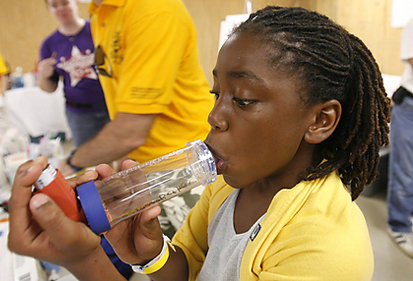
All Day NATIONAL Public Hearing on a New Federal Ozone Standard
Thursday, January 29th, 9am to 7:30 pm
Arlington City Hall, 101 W. Abram
There are only three national public hearings on the possibility of lowering the national federal ozone, or smog, standard. One is in Washington DC, another is in Sacramento, California and the third is right here in Arlington, Texas. We need everyone that can come and speak for 5 minutes on the importance of cleaner air to do so. You know industry and elected officials hostile to the EPA and the Clean AIr Act will be well-represented
To secure your 5-minute speaking slot, e-mail Eloise Shepard and ask for one in the time period during the day on Thursday most convenient for you. Please do it asap: shepherd.eloise@epa.gov.
There are at least two very good reasons why North Texas residents should support a new lower smog standard of 60 parts per billion – the lowest standard under consideration by the EPA.
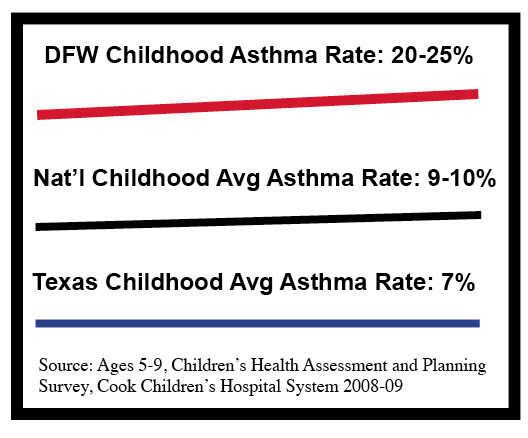 1. DFW has Epidemic Childhood Asthma Rates
1. DFW has Epidemic Childhood Asthma Rates
According to a first-of-its kind survey in 2008 by Cook Children’s Hospital, one out of every four DFW children ages 5-9 suffered from asthma. That was more than twice the national average, and more than three times the average for the state of Texas. Asthma is the most common cause of missed school days and is one of most common causes of Emergency Room visits and hospitalizations.
The DFW Hospital Council estimates nearly 1500 children in Dallas County visited an emergency room or were admitted to a hospital due to asthma in 2012. Dallas County has the highest number of child asthma hospitalization in the state.
According to EPA itself, a new 60 parts per billion (ppb) standard for ozone would eliminate roughly 1.8 million asthma attacks, 1.9 million missed school days, and 6,400 premature deaths nationwide – 95% of all ozone-related deaths. Few regions would benefit more from such a lower ozone standard than DFW.
2. It’s One of the Few Ways to Force Reductions in Harmful Air Pollution in Texas 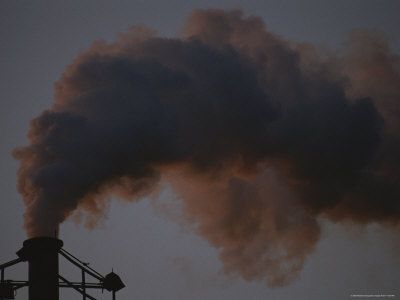
Texas is a place where industry rides rough shod over state regulators and citizens don’t have a level playing field to seek relief from the adverse health consequences of air pollution. Tougher federal ozone standards are one of the only ways to reduce air pollution from large local sources like the cement kilns in Midlothian, gas facilities in the Barnett Shale, and coal plants in East Texas.
Lower federal ozone standards over the last two decades, combined with grassroots campaigns have resulted in the lower volumes of smog pollution from the Midlothian cement kilns, plus reductions in other kinds of harmful pollution from the kilns as well, like particulate matter, and carcinogens. A new 60 ppb ozone standard would mean the kilns would have to add state-of-the-art controls to bring down those totals even more – to as much as 90% reductions. The same is true with the East Texas coal plants and with polluting gas facilities. To get down to 60 ppb ozone levels in DFW could mean deep cuts from the largest sources of industrial air pollution in North Texas. Something that probably won’t happen without a new, lower federal ozone standard.
And that won't happen without a lot of you showing up on Thursday to say you want and need cleaner air to breathe. Reserve your 5-minute speaking slot now. It's a good investment if you live in Texas.
Don’t put away those gas masks yet: EPA’s National Ozone Public Hearing is Next Thursday in Arlington
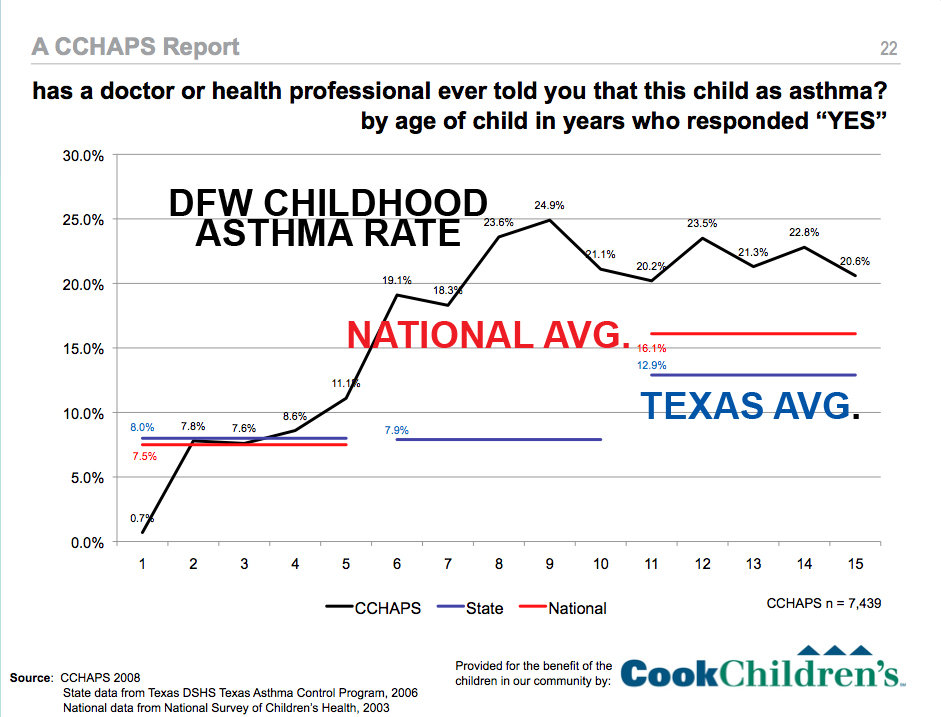
All Day NATIONAL Public Hearing on a New Federal Ozone Standard
Thursday, January 29th, 9am to 7:30 pm
Arlington City Hall, 101 W. Abram
(To secure a 3-minute speaking slot, e-mail Eloise Shepard and ask for one in the time period most convenient for you. Slots are going fast (and not necessarily to citizens), so do it asap: shepherd.eloise@epa.gov)
It's Round Two of January's clean air public hearing marathon, and the biggest has been saved until last.
One of only three national public hearings on lowering the federal ozone, or smog standard, is taking place here in DFW, at Arlington City Hall all day next Thursday January 29th, from 9 am to 7:30 pm.
Last week saw a state-sponsored hearing on another TCEQ do-nothing DFW clean air plan. But the state wouldn't even have to pay lip service to such plans were it not for the requirement to meet a federal ozone level and the region's inability to do so over the last two decades.
Lowering the federal ozone level means it will be tougher in the future for the state to claim it doesn't have to implement any new pollution controls on cement kilns, coal plants, or gas facilities. More importantly, enforcement of a tougher standard means better public health: fewer "bad air days," fewer asthma attacks, fewer trips to the emergency room because your child can't breath, and fewer deaths caused by dirty air.
That's important because reports like the child heath survey from Cook Children's hospital in 2009 showed that childhood asthma rates in DFW were twice the state average and almost 10% higher than the national average. It called the prevalence of asthma among local children an "epidemic."
Currently, the national ozone standard is 75 parts per billion (ppb) – which DFW is still at least three years away from reaching even under the rosiest of scenarios. (Right now our average is 81 ppb, and that's only because of a wetter and cooler summer in 2014). But that 75 ppb number is a political compromise – not one grounded in science. Based on public health studies the EPA's own independent board of specialists has recommended a range of 60 to 70 ppb at least three times since 2008, with an emphasis on the lower end of that range. Now it looks as if the EPA is finally willing to follow through on that recommendation.
EPA's national ozone standard sets the goal of cleaner air that every state must work toward. It drives all new clean air plans. like the one the state of Texas is proposing for DFW right now. The lower the standard, the more pollution has to be reduced. The more pollution has to be reduced, the more controls have to be added to major sources of air pollution to get that reduction. That's how you get long-term clean air progress in states like Texas that refuse to act on their own.
A significant reduction in the federal standard – from 75 (ppb) to as low as 60 ppb would make it much, much harder for Texas to avoid new controls on industry. To give you some idea of how much harder, consider that the state's "plan" for compliance with the current 75 ppb level is completely dependent on a new EPA gasoline mix coming onto the market in 2017. Even then, it's own estimates say that it won't get down below 75 at least three or four monitoring sites. Just one monitor site out of compliance means the whole region is in violation. Short of a huge rise in the use of electric cars, more huge decreases in vehicle pollution aren't expected. Additional significant drops in smog that would be required under a new, lower standard would have to include controls on major industrial sources – like the cement kilns, coal plant and, yes even gas facilities.
When you have a much lower ozone standard, you have to reduce smog by addressing ALL sources of air pollution.
Finding a way to comply with a lower national ozone standard is how more modern pollution controls were mandated almost a decade ago at the Midlothian cement plants. Meeting that new ozone standard meant pollution from the kilns had to be reduced and that made it more possible for Downwinders' "Green Cement" campaign to work with local governments. Today, there are no obsolete "wet kilns" left in Texas – they've all been replaced with more modern dry kiln operations. This has resulted in a reduction of hundreds, even thousands, of tons of smog-forming air pollution from these huge sources every year. We still have to require state-of-the-art Selective Calaytic Reduction (SCR) on the kilns, but they're releasing far less pollution than they were even five years ago because they've had to comply with a new federal ozone level.
With a new, lower ozone standard, the same could be true of new controls on gas facilities, like the 650 large compressors in North Texas, and the East Texas coal plants. That's why it's important for Texas residents to fight for the lowest possible standard this time around. When you testify, please make sure you request a new standard of NOT MORE THAN 60 PARTS PER BILLION.
According to a recent EPA staff analysis, an ozone standard of 60 ppb would reduce asthma deaths in the US by 95%, compared to only a 50% reduction under a 70 ppb level. If you want air that can eliminate all but a small fraction of respiratory problems associated with outdoor pollution, you need to press for a 60 ppb standard.
Needless to say industry is fighting back hard against such a standard, using its usual doom and gloom forecasts of economic hardship. This is the same argument that was used against the current ozone standard – the one we have now in the middle of the biggest economic boom in a decade. In fact, the technology for bringing down pollution levels currently exists in many industries – including kilns, coal plants and compressors. It's not experimental and it's not too expensive to use, as demonstrated by its use right now in those industries. We just have to require its use in states like Texas that are refusing to implement progress. That's why this new standard is so important – it will make the state take action it would not otherwise take. It's one of the only ways citizens who care about cleaner air in Texas can force progress.
Likewise, the Texas Commission on Environmental Quality's own toxicologist, Michael "Smog Ain't Bad For You" Honeycutt will also be testifying. TCEQ knows that a lower standard will force its hand on new controls. It will be pulling out all the stops to use its influence and that of sympathetic elected officials to scuttle any change. Using ideologically-based arguments supported by industry-financed studies, the TCEQ will say there are no real benefits to reducing DFW smog. Those of you that know better have to show up and say so.
Speaking slots for the 29th are going very fast. Industry will be well-represented. Please don't get left out. We need your voice that day to call for a 60 ppb national ozone standard. E-mail the EPA at shepherd.eloise@epa.gov and reserve your time today.
Bottom Line: If You Think DFW Still Has A Smog Problem, Be in Arlington Tonight
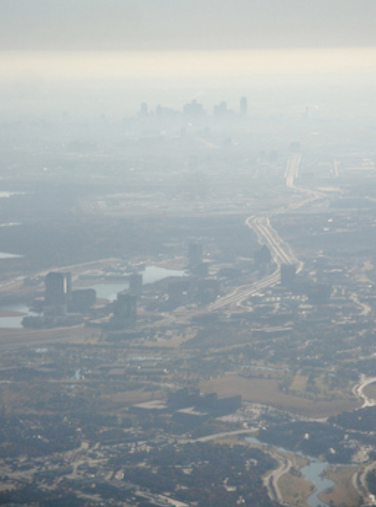 You don't have to have any special technical knowledge. You don't have to know regulatory or legal jargon. You just have to believe we still have a problem with smog in Dallas-Fort Worth. That's all it takes to participate in the air quality extravaganza happening tonight in Arlington. It's a rare two-for one chance to help the fight for cleaner air.
You don't have to have any special technical knowledge. You don't have to know regulatory or legal jargon. You just have to believe we still have a problem with smog in Dallas-Fort Worth. That's all it takes to participate in the air quality extravaganza happening tonight in Arlington. It's a rare two-for one chance to help the fight for cleaner air.
Public Hearing on the State's New DFW Air Plan 6:30 pm Tonight, Arlington City Hall, 101. W Abram
All you have to do is sign-up to speak, wait for your name to be called, and tell the state and the EPA representatives who'll be present that you want something better than a clean air plan that does nothing to get cleaner air except wait for a new federal gasoline formula to hit the market a year before the plan's deadline. The more people that do this, the more pressure EPA is under to reject this terrible state plan. Nothing fancy. Just show up and say you want better – that this region deserves better after two decades of being in violation of the Clean Air Act.
Click here to send prepared written comments to the state and EPA. You can add your own as well.
Roasting and Toasting of Retiring State Representative Lon Burnam – A Fundraiser for Downwinders at Risk, 7:30 -10 pm, Tonight, South Street Patio, 400 South Street – about four blocks east of Arlington City Hall
If you think DFW smog is still a problem, after you say your piece at the state hearing come and support the only group committed to trying making its elimination a priority – Downwinders at Risk. Since the mid-1990's we've been using these air plans to raise issues, get information, and sometimes even win victories that actually do lead to cleaner air. A big reason there's no more burning of hazardous waste in the Midlothian cement plants, and all of those cement plants have upgraded their equipment is because of the work we did around smog. Lately, we've been using them to drive home how much gas and oil pollution contribute to regional smog.
But we need your help – in terms of attendance at public hearings, and in terms of financial assistance. For your donation of $35 to this roasting and toasting of Lon, you get an evening of entertainment and take part in a salute to a real local clean air hero. And you make it more possible to keep challenging the status quo on behalf of your lungs.
CLICK HERE TO GET YOUR TICKETS ONLINE OR GET THEM AT THE DOOR TONIGHT
If you still think we have a smog problem, there's two things you can do about it tonight. Thanks.
